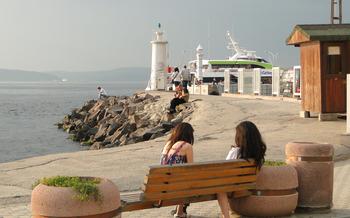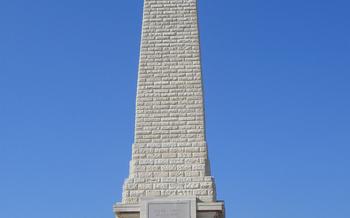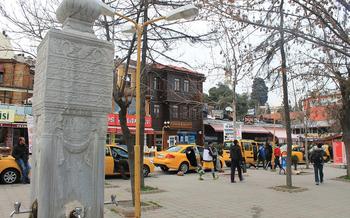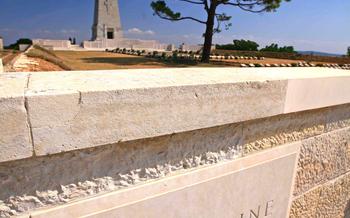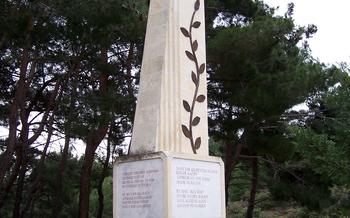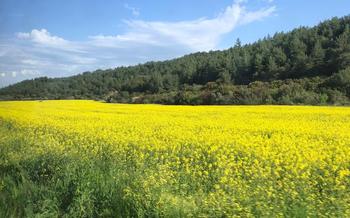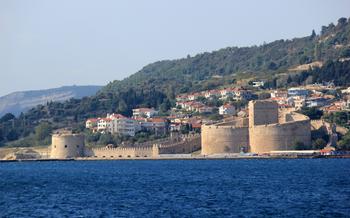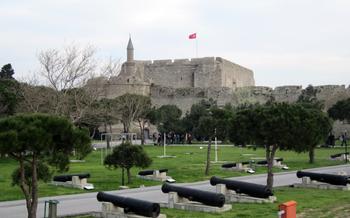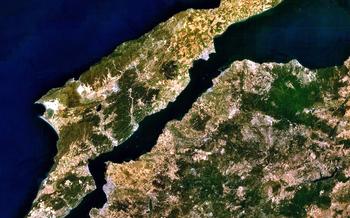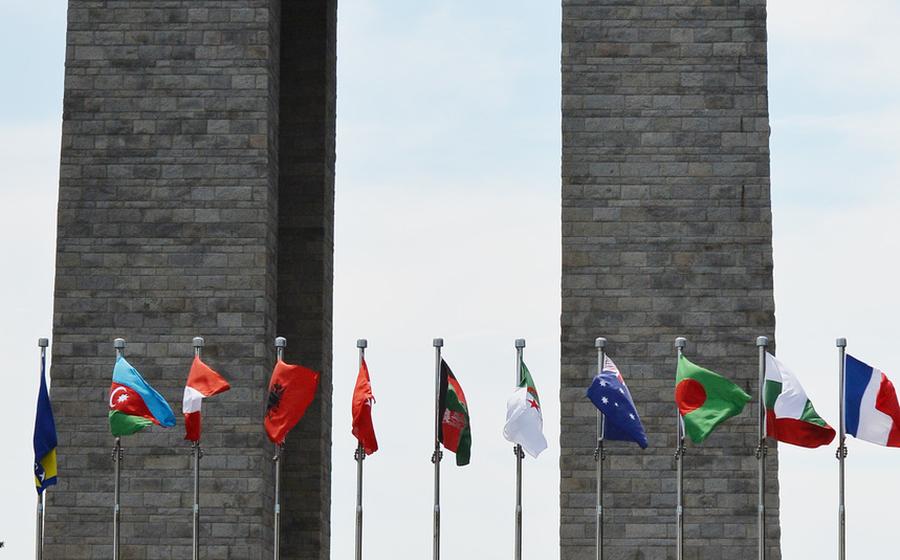
Çanakkale Martyrs' Memorial
- Çanakkale Martyrs' Memorial: A Tribute to Sacrifice and Heroism
- Historical Significance of the Battle of Gallipoli
- Exploring the Memorial Grounds
- Paying Respects at the Cemetery
- Witnessing the Dawn Ceremony
- Attending the Commemoration Ceremonies
- Interactive Exhibitions and Displays
- Guided Tours and Interpretive Programs
- Exploring the Surrounding Area
- Respectful Conduct and Etiquette
- Planning Your Visit
- Respecting the Local Culture and Customs
- Capture the Moment: Photography Tips
- Insider Tip: Unveiling Hidden Stories
Çanakkale Martyrs' Memorial: A Tribute to Sacrifice and Heroism
The Çanakkale Martyrs' Memorial stands as a testament to the indomitable spirit of the Turkish people and their unwavering commitment to their homeland. This sacred site commemorates the heroic sacrifices made by Turkish soldiers during the Battle of Gallipoli, a pivotal event in Turkish history that cemented the nation's identity and pride.
Historical Background: The Battle of Gallipoli, also known as the Gallipoli Campaign, was a significant military campaign fought during World War I. In 1915, Allied forces, including British, French, and Australian troops, launched an ambitious campaign to capture the Gallipoli Peninsula, with the aim of securing control of the Dardanelles Strait and ultimately knocking the Ottoman Empire out of the war. However, the Turkish forces, under the command of Mustafa Kemal Atatürk, mounted a fierce resistance, repelling the Allied invasion and inflicting heavy losses.
Architectural Design: The Çanakkale Martyrs' Memorial, designed by renowned Turkish architect Emin Onat, is a masterpiece of modern architecture that seamlessly blends symbolic elements with functional design. The memorial complex consists of a central plaza, surrounded by a series of commemorative structures, including a 57-meter-high obelisk, a museum, and a cemetery. The obelisk, a prominent feature of the memorial, represents the unwavering spirit of the Turkish soldiers who fought and died in the battle.
Commemorative Elements: Within the memorial grounds, visitors will find a multitude of commemorative elements that pay tribute to the fallen soldiers. The cemetery, the largest section of the memorial, is home to the graves of over 50,000 Turkish soldiers who lost their lives in the battle. Each grave is marked with a headstone bearing the soldier's name, rank, and unit, along with a poignant epitaph. Statues of Turkish soldiers, frozen in moments of valor and sacrifice, are scattered throughout the grounds, serving as a reminder of their unwavering courage and resilience.
Historical Significance of the Battle of Gallipoli
The Battle of Gallipoli, also known as the Dardanelles Campaign, was a pivotal military campaign fought during World War I. It took place on the Gallipoli Peninsula in the Ottoman Empire (present-day Turkey) from April 1915 to January 191The campaign was initiated by the Allied powers, primarily the British Empire and France, with the aim of capturing Constantinople (present-day Istanbul), the Ottoman capital, and securing a sea route to Russia.
The Turkish forces, under the leadership of Mustafa Kemal Atatürk, mounted a fierce resistance against the Allied invasion. Despite the superior military strength of the Allies, the Turkish forces held their ground, inflicting heavy casualties on the invaders. The campaign ultimately ended in a strategic defeat for the Allies, who were forced to withdraw their troops.
The Battle of Gallipoli holds immense historical significance for Turkey. It marked a turning point in the country's struggle for independence and became a defining moment in its national identity. The heroic resistance of the Turkish forces against the Allied invasion instilled a sense of national pride and resilience among the Turkish people. The battle also played a crucial role in shaping the political and military career of Mustafa Kemal Atatürk, who later became the founder and first president of the Republic of Turkey.
Exploring the Memorial Grounds
The Çanakkale Martyrs' Memorial is meticulously designed to honor the fallen soldiers and provide a serene environment for remembrance. The central plaza, surrounded by manicured gardens, serves as a gathering place for visitors to reflect and pay their respects. Commemorative monuments, including the towering 57-meter-high obelisk and statues of Turkish soldiers, stand tall, symbolizing the courage and sacrifice of those who fought in the Battle of Gallipoli. Inscriptions and plaques etched into the memorial walls provide historical context and honor the names of the fallen soldiers, creating a profound sense of reverence and respect. The serene atmosphere of the memorial grounds invites visitors to pause, reflect, and remember the sacrifices made during this pivotal battle in Turkish history.
Paying Respects at the Cemetery
The cemetery at the Çanakkale Martyrs' Memorial is a solemn and moving place, where visitors can pay their respects to the fallen soldiers who sacrificed their lives during the Battle of Gallipoli. The graves are arranged in neat rows, with headstones marking the resting places of soldiers from different nationalities and faiths. Each headstone tells a unique story, with epitaphs and memorials offering glimpses into the lives and sacrifices of the men who lie beneath. The cemetery serves as a powerful reminder of the futility of war and the profound loss suffered by all sides during this tragic conflict. Visitors can take a moment to reflect on the individual lives behind the headstones, honoring their memory and the legacy they left behind. The cemetery is a place of remembrance and reconciliation, where visitors can come to pay tribute to the fallen and learn from the lessons of history.
Witnessing the Dawn Ceremony
Every morning at the Çanakkale Martyrs' Memorial, a solemn and moving ceremony takes place as the Turkish flag is raised and the national anthem is played. This daily ritual is a powerful tribute to the fallen soldiers and a reminder of the sacrifices they made.
The dawn ceremony begins with the arrival of a small contingent of soldiers, who march in perfect formation to the central plaza of the memorial. As the sun begins to rise over the Dardanelles, the soldiers raise the Turkish flag to the sound of the national anthem, which echoes across the tranquil grounds.
Witnessing the dawn ceremony is a deeply emotional experience that evokes a sense of awe and gratitude. The sight of the Turkish flag flying high above the memorial, combined with the stirring melody of the national anthem, creates a profound sense of respect and remembrance.
The dawn ceremony is not only a tribute to the fallen soldiers of the Battle of Gallipoli but also a symbol of national pride and resilience. It is a reminder that even in the face of adversity, the Turkish people stood firm and defended their homeland.
For visitors to the Çanakkale Martyrs' Memorial, attending the dawn ceremony is a must. It is an opportunity to pay respects to the fallen soldiers, reflect on the sacrifices they made, and gain a deeper understanding of the historical significance of the Battle of Gallipoli.
Attending the Commemoration Ceremonies
Every year, the Çanakkale Martyrs' Memorial hosts solemn and poignant commemoration ceremonies that draw thousands of visitors from Turkey and around the world. These ceremonies serve as a powerful reminder of the sacrifices made by the soldiers who fought and fell during the Battle of Gallipoli.
The atmosphere during these ceremonies is one of deep respect and remembrance. Families of the fallen soldiers, dignitaries, and representatives from various countries gather to pay tribute to the heroes who gave their lives for their homeland. The ceremonies typically include speeches by prominent figures, prayers for the souls of the departed, and the laying of wreaths at the memorial.
International participation in these ceremonies is a testament to the global significance of the Battle of Gallipoli. Delegations from countries that were involved in the conflict, as well as representatives from international organizations, come together to honor the memory of the fallen soldiers and to promote peace and reconciliation.
Attending the commemoration ceremonies at the Çanakkale Martyrs' Memorial is a deeply moving and humbling experience. It is an opportunity to connect with history, to remember the sacrifices made by brave men, and to reflect on the futility of war.
Interactive Exhibitions and Displays
The Çanakkale Martyrs' Memorial features a modern and interactive museum that offers a comprehensive insight into the history of the Battle of Gallipoli and the experiences of the soldiers who fought there. Through a variety of engaging exhibitions and displays, visitors can delve deeper into the events that unfolded during this pivotal battle.
Multimedia presentations, including films and interactive displays, bring to life the stories of the soldiers, their sacrifices, and the broader context of the war. Visitors can explore personal artifacts and relics from the battle, such as uniforms, weapons, and other items that belonged to the soldiers, providing a tangible connection to the past. These exhibitions not only educate and inform but also create a profound emotional connection, allowing visitors to gain a deeper understanding of the human toll of war.
Guided Tours and Interpretive Programs
The Çanakkale Martyrs' Memorial offers guided tours and interpretive programs that provide visitors with a deeper understanding of the memorial and the Battle of Gallipoli. Professional historians or experts lead these tours, sharing detailed insights into the significance of the battle, the stories of the fallen soldiers, and the historical context of the events that transpired.
Thematic tours are also available, allowing visitors to explore different aspects of the memorial and its surroundings. Battlefield tours offer a chance to retrace the steps of the soldiers and gain a firsthand perspective of the military campaign. Historical walks and heritage trails delve into the rich history of the region and its cultural significance.
Educational programs and workshops are organized for students and groups to promote understanding of the historical importance of the Battle of Gallipoli. These programs utilize interactive activities, multimedia presentations, and discussions to engage participants and provide a comprehensive learning experience.
Exploring the Surrounding Area
Beyond the boundaries of the Çanakkale Martyrs' Memorial, the wider Gallipoli Peninsula beckons with its rich tapestry of history, natural beauty, and charming villages. Embark on a journey of discovery, tracing the footsteps of soldiers through a network of well-marked battlefield trails. Immerse yourself in the poignant stories of ANZAC Cove, where the first Allied landings took place, and Lone Pine, the site of fierce battles that left an enduring mark on the landscape. The peninsula offers a harmonious blend of history and nature, inviting visitors to explore its hidden gems and tranquil corners.
Respectful Conduct and Etiquette
The Çanakkale Martyrs' Memorial is a sacred site dedicated to the memory of the fallen soldiers who sacrificed their lives during the Battle of Gallipoli. As visitors, it is essential to demonstrate respect and sensitivity when exploring the memorial grounds. Appropriate attire is expected, with modest clothing that covers shoulders and knees. Maintaining silence and a contemplative demeanor is encouraged to honor the sacrifices made by the soldiers. Photography is permitted, but visitors should be mindful of their surroundings and avoid disturbing the solemn atmosphere. By showing respect and adhering to these guidelines, visitors can contribute to preserving the sanctity of the memorial and pay tribute to the heroes who fought for their country.
Planning Your Visit
Visiting the Çanakkale Martyrs' Memorial requires careful planning to ensure a respectful and meaningful experience. Here are some essential considerations:
-
Accessibility: The memorial is designed to be accessible to visitors with disabilities. Wheelchair ramps, accessible pathways, and designated parking areas are available to facilitate easy movement throughout the grounds.
-
Best Time to Visit: The best time to visit the memorial is during the spring or fall, when the weather is pleasant and the crowds are smaller. The commemoration ceremonies held on April 25th (ANZAC Day) and August 6th (Victory Day) are particularly significant and attract a large number of visitors.
-
Facilities and Amenities: The memorial grounds are equipped with essential facilities and amenities to enhance the visitor experience. Restrooms, a cafeteria, and a gift shop are available for convenience.
Respecting the Local Culture and Customs
When visiting the Çanakkale Martyrs' Memorial and exploring the surrounding area, it is essential to be respectful of local culture and customs. Remember that Turkey is a predominantly Muslim country, and visitors should dress modestly in public places, covering their shoulders and knees. Simple gestures like greeting people with a handshake or a nod can go a long way in showing respect and fostering positive interactions. Learning a few basic Turkish phrases, such as "Merhaba" for hello and "Teşekkür ederim" for thank you, can also be helpful in communicating with locals. Indulge in the region's rich culinary traditions by trying local dishes and delicacies, such as freshly caught seafood, traditional Turkish kebabs, and mouthwatering desserts like künefe. Embracing the local culture and customs not only enhances your travel experience but also shows respect for the community that has preserved the memory of the fallen soldiers at the Çanakkale Martyrs' Memorial.
Capture the Moment: Photography Tips
To capture the essence and beauty of the Çanakkale Martyrs' Memorial, it is important to consider the following photography tips:
-
Lighting Conditions: Aim to visit the memorial during the golden hours of early morning or late afternoon, when the soft, warm light casts a picturesque glow on the structures and grounds.
-
Composition and Framing: Utilize leading lines, such as the pathways or rows of headstones, to draw the viewer's eye into the image. Experiment with symmetry and depth of field to create visually striking compositions.
-
Capturing Emotions: Focus on capturing the emotions and atmosphere of the memorial through your photographs. Observe the expressions of visitors as they pay their respects, and zoom in on the details of the commemorative elements to convey the significance of the site.
Insider Tip: Unveiling Hidden Stories
To truly immerse yourself in the history and emotions of the Çanakkale Martyrs' Memorial, consider seeking out local guides or storytellers who can share personal anecdotes and lesser-known stories about the Battle of Gallipoli and the fallen soldiers. These passionate individuals often have a deep connection to the events that transpired and can provide unique insights that bring the past to life.
Engage in conversations with them, ask questions, and listen attentively to their narratives. They may share tales of individual soldiers' bravery, poignant accounts of sacrifice, or little-known historical facts that shed new light on the battle. These personal stories add a human dimension to the memorial, allowing you to connect with the experiences of those who fought and lost their lives.
Through these conversations, you'll gain a deeper understanding of the motivations, struggles, and sacrifices made by the soldiers from both sides. You'll come away with a newfound appreciation for the complexities of war and the lasting impact it has had on the region.
So, as you explore the Çanakkale Martyrs' Memorial, keep an ear out for local guides or storytellers who are willing to share their knowledge and stories. Embrace the opportunity to learn from their perspectives and gain a deeper understanding of the events that shaped this hallowed ground.

